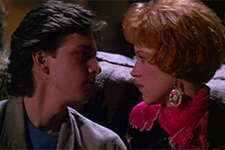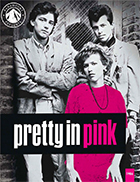Pretty in Pink
|  Pretty in Pink was the first of three collaborations between director Howard Deutch and writer John Hughes in as many years. Hughes, who had quickly become a household name among adolescent viewers in the mid-1980s with his quartet of suburban-set teen comedies—Sixteen Candles (1984), The Breakfast Club (1985), Weird Science (1985), and Ferris Bueller’s Day Off (1986)—was a prolific writer who could churn out entire screenplays over a couple of days. By mid-decade he clearly had more on the page than he could put on screen by himself, which is why he enlisted Deutch, a music video director who had worked on the marketing of Sixteen Candles, to helm not just Pretty in Pink, but also Some Kind of Wonderful (1987), which is essentially the same story but gender-flipped, and the John Candy-Dan Aykroyd comedy The Great Outdoors (1988). In reaching for a more conventionally dramatic portrait of American adolescence with a strong focus on socioeconomic divide, Pretty in Pink was more like The Breakfast Club than Hughes’s other teen comedies, which were broad and farcical and amusingly raunchy. If the film has a weakness, it is that it takes itself a bit too seriously, and its portrait of money-strapped misfits trying to swim against the tide in a high school full of not just rich snobs, but uber-rich snobs who exist in their own parallel universe of Miami Vice suits, BMWs, feathered mullets, and debauched mansion parties. It all feels too embellished and heightened, which was generally true of Hughes’s previous teen films, but here runs aground on the dramatic stabs at not just emotional, but social realism. There are certainly funny moments and one completely out-of-place Ferris Bueller-esque breakage of the fourth wall, but otherwise Pretty in Pink is quite serious about its business. Like Sixteen Candles, Pretty in Pink is a romance in which a girl pines for a boy she thinks she can never have. Both female protagonists are played by Molly Ringwald (who also had a prominent role in The Breakfast Club), but her Andie is much different from Sixteen Candles’s Samantha. Both are outsiders, but rather than being an underclassman wallflower, Andie stands out from the crowd with her unique persona and look. A would-be fashion designer, she assembles her own clothes out of finds at vintage clothing stores, which gives her a striking, distinctive appearance amid her school’s interchangeable preppies, but also makes her an object of scorn because, well, she looks different. And also she’s poor—literally from the wrong side of the tracks in a school that appears to be populated entirely by rich kids, with the exception of Andie’s best friend, Duckie (Jon Cryer), a fellow outcast with a penchant for unique stylings (he borrows liberally from’50s greasers, literary academics, and Frank Sinatra). Duckie, who is sarcastic, extroverted, and too clever for his own good, is secretly in love with Andie, but she has no attraction to him, which is why she treats him like a kid brother (he is, to quote Ryan Reynolds in Just Friends, stuck in the “Friend Zone”). Instead, Andie has eyes for Blane (Andrew McCarthy), the most sensitive and quiet member of her high school’s elite clique of “richies,” and he has eyes for her, as well. Blane’s best friend is Steff (James Spader), a supercilious prick who wears his disdain for everyone around him with the kind of flippant smarm that only Spader can muster (he is so unctuous that you can’t help but think that he is secretly playing the character as a parody). Blane is also attracted to Andie, but she has repeatedly turned down his crude sexual advances, so he has to cover for himself by dismissing her as trash and acting condescending about Blane’s liking her. On the flip side, Duckie is incensed that Andie would be in any way interested in one of “them,” thus demonstrating how thoughtless stereotyping cuts both ways. Just because one is rich does not mean that one is inherently shallow or mean, although Blane eventually demonstrates that the social pressures of being with the “right” kind of girl might be more than he can manage. McCarthy has a tricky role here, as he has to make Blane appealing while also conveying an inner weakness that, in Hughes’s original treatment, turned him into the very epitome of what Duckie assumed he was. But, that was not what test audiences wanted, and Pretty in Pink was turned at the last minute into a triumphant cross-socioeconomic romance par excellence. Interestingly, though, the film’s most compelling drama is not the Blane-Andie-Duckie love triangle, but rather the relationship between Andie and her down-on-his-luck father, Jack (Harry Dean Stanton), who was dumped by Andie’s mom some years ago and is struggling to raise a teenage daughter while nursing his own broken heart. Stanton is too good of an actor not to make Jack fundamentally compelling, and his interactions with Andie suggest a man who has lost his sense of meaning and self and therefore has a hard time even finding a reason to get up in the morning (not incidentally, the first scene finds Andie waking rousting him out of bed). He puts on a brave face and lies to Andie about job prospects, but she is too smart and emotionally mature to fall for it, and their moment of finally having it out (“She’s gone and she’s not coming back!” Andie yells at him) is the film’s one true moment of emotional rending. It’s a great scene of real coming to terms, which makes the teen romance angle, which is ostensibly the main plot, feel a bit forced and contrived. And then there’s the music. Pretty in Pink, like Some Kind of Wonderful, is a compendium of the British New Wave pop and rock that was filling the airwaves of alternative and college radio stations in the mid-’80s (Andie works in a record store alongside Annie Potts’s Iona, a kind of stand-in mother figure of constantly evolving style who is ostensibly twice Andie’s age but looks like she just graduated). Hughes’s soundtracks had always been cutting edge, but they had also been extremely eclectic. Pretty in Pink’s soundtrack, on the other hand, is like a greatest hits of the post-punk New Wave, with its lineup that includes Orchestral Manoeuvres in the Dark (whose “If You Leave,” which plays during the climactic prom sequence, became a romantic anthem), the Psychedelic Furs (who recorded a new version of the title track, which they originally recorded in 1981 when Hughes was still writing for The National Lampoon), INXS, New Order, Echo & the Bunnymen, and The Smiths, among others. The film itself also includes a sequence in which Duckie lip-synchs Otis Redding’s “Try a Little Tenderness” in an energetic and wholly misappropriated bid to woo Andie on a date, but Pretty in Pink is best remembered musically for its wholesale incorporation of an entire subgenre of ’80s pop, effectively bringing it into the teen mainstream.
Copyright © 2019 James Kendrick Thoughts? E-mail James Kendrick All images copyright © Paramount Home Entertainment | |||||||||||||||||||||||||||||
Overall Rating: 

 (2.5)
(2.5)


